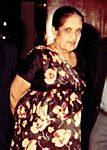July 1960 Ceylonese parliamentary election facts for kids
|
|||||||||||||||||||||||||||||||
|
151 seats in the House of Representatives of Ceylon 76 seats were needed for a majority |
|||||||||||||||||||||||||||||||
|---|---|---|---|---|---|---|---|---|---|---|---|---|---|---|---|---|---|---|---|---|---|---|---|---|---|---|---|---|---|---|---|
|
|||||||||||||||||||||||||||||||
|
|||||||||||||||||||||||||||||||
The July 1960 parliamentary election in Ceylon (which is now called Sri Lanka) was a really important event. It was held to decide who would lead the country. This election happened just a few months after another election in March 1960, because that first election didn't give any single party enough seats to form a strong government.
Why Another Election Was Needed
The March 1960 election had a problem. Neither of the two main political parties in Ceylon won enough seats to have a clear majority. This meant they couldn't easily form a stable government. Because of this, a new election had to be called quickly to find a clear leader for the country.
The Main Parties and Their Ideas
Two major parties competed in this election:
- The Sri Lanka Freedom Party (SLFP): This party had faced a tough time after its leader, S. W. R. D. Bandaranaike, was sadly killed the year before. His wife, Sirimavo Bandaranaike, stepped up to become the new leader. She promised to continue her husband's plans. This included supporting the Sinhala Only Act, which made Sinhala the official language. She also wanted to send back people of Indian origin who worked on tea estates to India. However, she also said she would try to find common ground with the Federal Party, which represented Tamil-speaking people.
- The United National Party (UNP): This party was led by Dudley Senanayake. Unlike the SLFP, the UNP did not want to make a deal with the Federal Party. The two parties also had different ideas about how the country's economy should work. The SLFP wanted a more socialist approach, meaning the government would take control of some private businesses and religious schools. The UNP, however, preferred to keep these in private hands.
What Happened Next?
Even though the United National Party (UNP) received more total votes from the public, the Sri Lanka Freedom Party (SLFP) won more seats in the parliament. This meant the SLFP got just enough seats to form a government.
Because of this victory, Sirimavo Bandaranaike became the new prime minister. She made history as the world's first female prime minister!
| Party | Votes | % | Seats | |
|---|---|---|---|---|
| United National Party | 1,144,166 | 37.19 | 30 | |
| Sri Lanka Freedom Party | 1,022,171 | 33.22 | 75 | |
| Lanka Sama Samaja Party | 224,995 | 7.31 | 12 | |
| Illankai Tamil Arasu Kachchi | 213,733 | 6.95 | 16 | |
| Mahajana Eksath Peramuna | 106,816 | 3.47 | 3 | |
| Communist Party of Ceylon | 90,219 | 2.93 | 4 | |
| All Ceylon Tamil Congress | 46,804 | 1.52 | 1 | |
| Lanka Democratic Party | 30,207 | 0.98 | 2 | |
| National Liberation Front | 14,030 | 0.46 | 2 | |
| Others | 183,728 | 5.97 | 6 | |
| Total | 3,076,869 | 100.00 | 151 | |
| Registered voters/turnout | 3,724,507 | 75.9 | ||
| Source: Nohlen et al. | ||||



